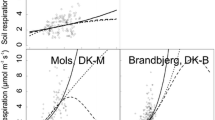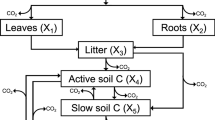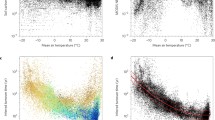Abstract
Arid and semiarid ecosystems (drylands) may dominate the trajectory of biosphere-to-atmosphere carbon (C) exchange, and understanding dryland CO2 efflux is important for C cycling at the global-scale. However, unknowns remain regarding how temperature and moisture interact to regulate dryland soil respiration (R s ), while ‘islands of fertility’ in drylands create spatially heterogeneous R s . At a site in southeastern Utah, USA we added or removed litter (0–650 % of control) in plots associated with either shrubs or biological soil crust-dominated interspaces between vascular plants. We measured R s , soil temperature (Ts), and water content (θ) repeatedly from October 2013 to November 2014. R s was highest following rain in late summer at Ts ~30 °C, and lowest mid-summer at Ts > 40 °C, resulting in apparent negative temperature sensitivity of R s at high temperatures, and positive temperature sensitivity at low-moderate temperatures. We used Bayesian statistical methods to compare models capturing a range of hypothesized relationships between Ts, θ, and R s . The best model indicates that apparent negative temperature sensitivity of R s at high Ts reflects the control of water content, not high temperatures. Modeled Q10 ranged from 2.7 to 1.4 between 5 and 45 °C. Litter addition had no effect on Q10 or reference respiration (R ref = R s at 20 °C and optimum θ) beneath shrubs, and little effect on R ref in interspaces, yet R ref was 1.5 times higher beneath shrubs than in interspaces. Altogether, these results suggest reduced R s often observed at high Ts in drylands is dominated by the control of θ, and, on shorter-timescales, variable litter inputs exert minimal control over R s .






Similar content being viewed by others
References
Adair EC, Parton WJ, Del Grosso SJ et al (2008) Simple three-pool model accurately describes patterns of long-term litter decomposition in diverse climates. Glob Change Biol 14:2636–2660
Aguiar MNR, Sala OE (1999) Patch structure, dynamics and implications for the functioning of arid ecosystems. Trends Ecol Evol 14:273–277
Ahlström A, Raupach MR, Schurgers G et al (2015) The dominant role of semi-arid ecosystems in the trend and variability of the land CO2 sink. Science 348:895–899
Austin A, Yahdjian L, Stark J et al (2004) Water pulses and biogeochemical cycles in arid and semiarid ecosystems. Oecologia 141:221–235
Barnes PW, Throop HL, Archer SR et al (2015) Sunlight and soil-litter mixing: drivers of litter decomposition in drylands. Progress Bot 76:273–302
Barron-Gafford GA, Cable JM, Bentley LP, Scott RL, Huxman TE, Jenerette GD, Ogle K (2014) Quantifying the timescales over which exogenous and endogenous conditions affect soil respiration. New Phytologist 202:442–454
Bond-Lamberty B, Thomson A (2010) A global database of soil respiration data. Biogeosciences 7:1915–1926
Boone RD, Nadelhoffer KJ, Canary JD, Kaye JP (1998) Roots exert a strong influence on the temperature sensitivity of soil respiration. Nature 396:570–572
Burke IC, Kaye JP, Bird SP, Hall SA, Mcculley RL, Sommerville GL (2003) Evaluating and testing models of terrestrial biogeochemistry: the role of temperature in controlling decomposition. Models in ecosystem science. Princeton University Press, Princeton, pp 225–253
Cable JM, Ogle K, Lucas RW et al (2011) The temperature responses of soil respiration in deserts: a seven desert synthesis. Biogeochemistry 103:71–90
Cable JM, Ogle K, Barron-Gafford GA et al (2013) Antecedent conditions influence soil respiration differences in shrub and grass patches. Ecosystems 16:1230–1247
Castillo-Monroy AP, Maestre FT, Rey A, Soliveres S, Garcia-Palacios P (2011) Biological soil crust microsites are the main contributor to soil respiration in a semiarid ecosystem. Ecosystems 14:835–847
Darrouzet-Nardi A, Reed SC, Grote EE, Belnap J (2015) Observations of net soil exchange of CO2 in a dryland show experimental warming increases carbon losses in biocrust soils. Biogeochemistry 126:363–378
Davidson EA, Janssens IA (2006) Temperature sensitivity of soil carbon decomposition and feedbacks to climate change. Nature 440:165–173
Davidson, EA, Samanta S, Caramori SS, Savage K (2012) The Dual Arrhenius and Michaelis–Menten kinetics model for decomposition of soil organic matter at hourly to seasonal time scales. Glob Change Biol 18:371–384
Davidson EA, Savage KE, Finzi AC (2014) A big-microsite framework for soil carbon modeling. Glob Change Biol 20:3610–3620
Fierer N, Craine JM, Mclauchlan K, Schimel JP (2005) Litter quality and the temperature sensitivity of decomposition. Ecology 86:320–326
Foley JA (1995) An equilibrium model of the terrestrial carbon budget. Tellus B 47:310–319
Garcia-Moya E, Mckell CM (1970) Contribution of shrubs to the nitrogen economy of a desert-wash plant community. Ecology 51:81–88
Garfin G, Franco G, Blanco H et al (2014) Chapter 20: Southwest. Climate Change Impacts in the United States: The Third National Climate Assessment. US Global Change Research Program, pp 462–486
Heinemeyer A, Di Bene C, Lloyd AR et al (2011) Soil respiration: implications of the plant-soil continuum and respiration chamber collar-insertion depth on measurement and modelling of soil CO2 efflux rates in three ecosystems. Eur J Soil Sci 62:82–94
Huxman T, Snyder K, Tissue D et al (2004) Precipitation pulses and carbon fluxes in semiarid and arid ecosystems. Oecologia 141:254–268
Janssens IA, Kowalski AS, Ceulemans R (2001) Forest floor CO2 fluxes estimated by eddy covariance and chamber-based model. Agric For Meteorol 106:61–69
Lal R (2004) Carbon sequestration in dryland ecosystems. Environ Manag 33:528–544
Leff J, Nemergut D, Grandy AS, O’neill S, Wickings K, Townsend A, Cleveland C (2012) The effects of soil bacterial community structure on decomposition in a tropical rain forest. Ecosystems 15:284–298
Leifeld J, Fuhrer J (2005) The temperature response of CO2 production from bulk soils and soil fractions is related to soil organic matter quality. Biogeochemistry 75:433–453
Lepock JR (2003) Cellular effects of hyperthermia: relevance to the minimum dose for thermal damage. Int J Hyperth 19:252–266
Lloyd J, Taylor JA (1994) On the temperature dependence of soil respiration. Funct Ecol 8:315–323
Luo Y, Zhou X (2010) Soil respiration and the environment. Academic press, Burlington
Manzoni S, Schaeffer SM, Katul G, Porporato A, Schimel JP (2014) A theoretical analysis of microbial eco-physiological and diffusion limitations to carbon cycling in drying soils. Soil Biol Biochem 73:69–83
Mccluney KE, Belnap J, Collins SL et al (2012) Shifting species interactions in terrestrial dryland ecosystems under altered water availability and climate change. Biol Rev 87:563–582
Moyano FE, Manzoni S, Chenu C (2013) Responses of soil heterotrophic respiration to moisture availability: an exploration of processes and models. Soil Biol Biochem 59:72–85
Nadelhoffer K, Aitkenhead J, Boone R et al (2006) The DIRT experiment. Forests in Time: The Environmental Consequences of 1,000 Years of Change in New England, 300
Nielsen UN, Ball BA (2015) Impacts of altered precipitation regimes on soil communities and biogeochemistry in arid and semi-arid ecosystems. Glob Change Biol 21:1407–1421
Noy-Meir I (1973) Desert ecosystems: environment and producers. Ann Rev Ecol Syst 4:25–51
Parton WJ, Ojima DS, Cole CV, Schimel DS (1994) A general model for soil organic matter dynamics: sensitivity to litter chemistry, texture and management. In: In 1992, Proceedings of the symposium on quantitative modeling of soil forming processes, Minneapolis, pp 147–167
Pietikäinen J, Pettersson M, Bååth E (2005) Comparison of temperature effects on soil respiration and bacterial and fungal growth rates. FEMS Microbiol Ecol 52:49–58
Poulter B, Frank D, Ciais P et al (2014) Contribution of semi-arid ecosystems to interannual variability of the global carbon cycle. Nature 509:600–603
Reed SC, Coe KK, Sparks JP, Housman DC, Zelikova TJ, Belnap J (2012) Changes to dryland rainfall result in rapid moss mortality and altered soil fertility. Nat Clim Change 2:752–755
Reynolds JF, Smith DMS, Lambin EF et al (2007) Global desertification: building a science for dryland development. Science 316:847–851
Rotenberg E, Yakir D (2010) Contribution of semi-arid forests to the climate system. Science 327:451–454
Ryan MG, Law BE (2005) Interpreting, measuring, and modeling soil respiration. Biogeochemistry 73:3–27
Savage K, Davidson EA, Richardson AD, Hollinger DY (2009) Three scales of temporal resolution from automated soil respiration measurements. Agric For Meteorol 149:2012–2021
Scanlon BR, Andraski BJ, Bilskie J (2002) Miscellaneous methods for measuring matric or water potential. In: Methods of soil analysis part 4, pp 643–673. Soil Science Society of America, Madison, WI
Schimel DS (2010) Drylands in the earth system. Science 327:418–419
Schlesinger W, Pilmanis A (1998) Plant-soil Interactions in deserts. Biogeochemistry 42:169–187
Schlesinger WH, Belnap J, Marion G (2009) On carbon sequestration in desert ecosystems. Glob Change Biol 15:1488–1490
Seager R, Ting M, Li C, Naik N, Cook B, Nakamura J, Liu H (2013) Projections of declining surface-water availability for the southwestern United States. Nat Clim Change 3:482–486
Shipper LA, Hobbs JK, Rutledge S, Arcus VL (2014) Thermodynamic theory explains the temperature sensitivity of soil microbial processes and high Q10 values at low temperatures. Glob Change Biol 20:3578–3586
Sierra CA, Trumbore SE, Davidson EA, Vicca S, Janssens I (2015) Sensitivity of decomposition rates of soil organic matter with respect to simultaneous changes in temperature and moisture. J Adv Modeling Earth Syst 7:335–356
Tucker CL, Bell J, Pendall EP, Ogle K (2013) Does declining carbon-use efficiency explain thermal acclimation of soil respiration with warming? Glob Change Biol 19(1):252–263
Tucker CL, Tamang S, Pendall EP, Ogle K (2016) Shallow snowpack inhibits soil respiration in sagebrush steppe through multiple biotic and abiotic mechanisms. Ecosphere (in press)
Van Gestel NC, Reischke S, Bååth E (2013) Temperature sensitivity of bacterial growth in a hot desert soil with large temperature fluctuations. Soil Biol Biochem 65:180–185
Vehtari A, Gelman A (2014) WAIC and cross-validation in Stan. Submitted. http://www.stat.columbia.edu/~gelman/research/unpublished/waic_stan.pdf. Accessed date on May 27 2014
Wang B, Zha T, Jia X, Wu B, Zhang Y, Qin S (2014) Soil moisture modifies the response of soil respiration to temperature in a desert shrub ecosystem. Biogeosciences 11:259–268
Wang B, Zha T, Jia X, Gong JN, Wu B, Bourque CPA, Zhang Y, Qin SG, Chen GP, Peltola H (2015) Microtopographic variation in soil respiration and its controlling factors vary with plant phenophases in a desert-shrub ecosystem. Biogeosciences 12:5705–5714
Wertin TM, Phillips SL, Reed SC, Belnap J (2012) Elevated CO2 did not mitigate the effect of a short-term drought on biological soil crusts. Biol Fertil Soils 48:797–805
Williams JW, Jackson ST (2007) Novel climates, no-analog communities, and ecological surprises. Front Ecol Environ 5:475–482
Wohlfahrt G, Fenstermaker LF, Arnone Iii JA (2008) Large annual net ecosystem CO2 uptake of a Mojave Desert ecosystem. Glob Change Biol 14:1475–1487
Acknowledgments
This material is based upon work supported by the U.S. Department of Energy Office of Science, Office of Biological and Environmental Research Terrestrial Ecosystem Sciences Program, under Award Number DE-SC-0008168 and by the U.S. Geological Survey Ecosystems Mission Area. We thank Pete Chuckran for his excellent work with plot installation and measurements, and we are appreciative of all of the technicians who worked on this project. We are grateful to our D-DIRT collaborators Heather Throop and Marie-Anne de Graaff for their ideas and collaboration. We also thank Jessie Young for her valuable feedback on an earlier version of the manuscript. Any use of trade, firm, or product names is for descriptive purposes only and does not imply endorsement by the U.S. Government.
Author information
Authors and Affiliations
Corresponding author
Additional information
Responsible Editor: Jonathan Sanderman.
Electronic supplementary material
Below is the link to the electronic supplementary material.
10533_2016_200_MOESM1_ESM.zip
Supplementary material 1 Compressed folder containing model code, for all 20 models in.R and.stan format, data in.csv format, as well as instructions for installing Rstan and running the code provided (ZIP 47 kb)
10533_2016_200_MOESM2_ESM.xlsx
Supplementary material 2 Table containing prior distributions, prior 95 % intervals, and posterior 95 % credible intervals for each parameter in each model (XLSX 32 kb)
10533_2016_200_MOESM3_ESM.pdf
Supplementary material 3 Maximum soil respiration (R s ) for 99 studies taken from the Global Soil Respiration Database (Bond-Lamberty and Thomson 2010) compared to mean annual precipitation (MAP) and mean annual temperature (MAT) (PDF 160 kb)
Rights and permissions
About this article
Cite this article
Tucker, C.L., Reed, S.C. Low soil moisture during hot periods drives apparent negative temperature sensitivity of soil respiration in a dryland ecosystem: a multi-model comparison. Biogeochemistry 128, 155–169 (2016). https://doi.org/10.1007/s10533-016-0200-1
Received:
Accepted:
Published:
Issue Date:
DOI: https://doi.org/10.1007/s10533-016-0200-1




